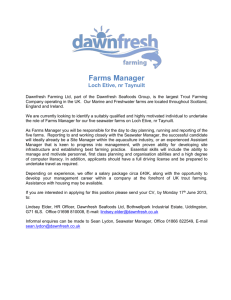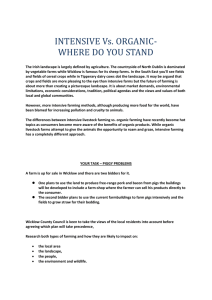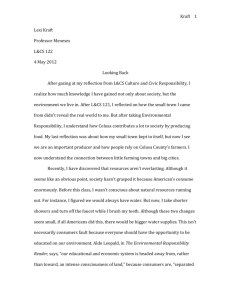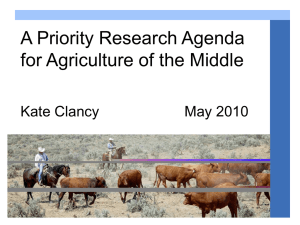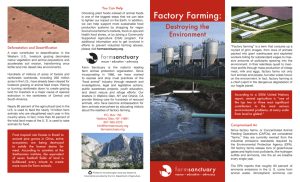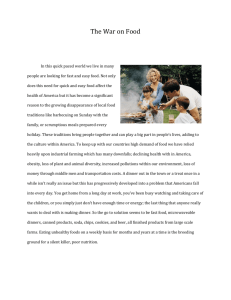Sustainable Agriculture - George Washington High School
advertisement
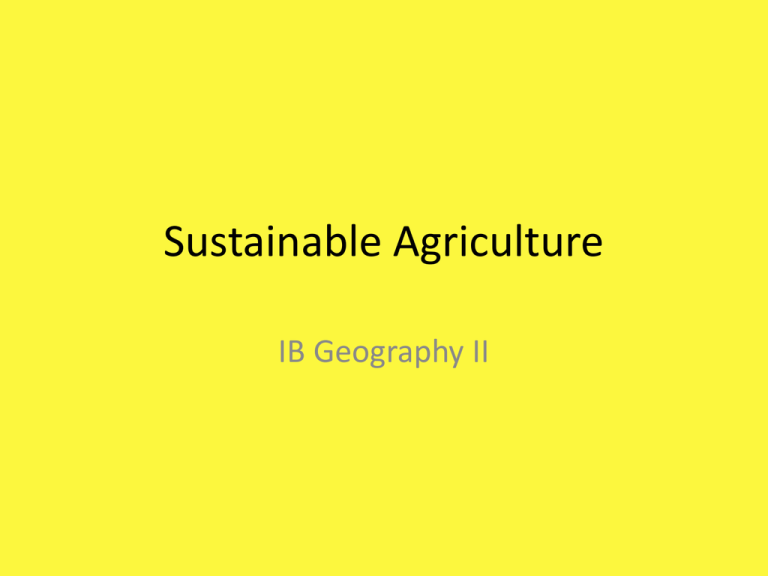
Sustainable Agriculture IB Geography II Objective • By the end of this lesson, students will be able to examine the principles of sustainable agriculture and explain the environmental costs of increasing food production. • Essay Planning Tool Question: Examine the principles of sustainable agriculture and explain the environmental costs of increasing food production. Opening Reading Activity • Close Read and Annotate: “The Worst Mistake in the History of the Human Race” By Jared Diamond • As you read, find: – The main idea – Supporting details that support it • In elbow partners, discuss: – The main idea and supporting details – Your thoughts? Do you agree or disagree? – Today we will be talking about sustainable agriculture. How does this text apply to that? Starting Activity • Take the next two minutes to read the following excerpt. • Then answer this question: Is sustainable farming possible? Sustainability rests on the principle that we must meet the needs of the present without compromising the ability of future generations to meet their own needs. Therefore, stewardship of both natural and human resources is of prime importance. Stewardship of human resources includes consideration of social responsibilities such as working and living conditions of laborers, the needs of rural communities, and consumer health and safety both in the present and the future. Stewardship of land and natural resources involves maintaining or enhancing this vital resource base for the long term. Sustainability • Sustainability is a relatively straightforward concept to define but is harder to achieve. Think of it as a three legged stool. The stool needs all three legs to remain standing Sustainable Agriculture • This term refers to the ability of a farm to produce food indefinitely, without causing irreversible damage to ecosystems. • Sustainable farming reduces or prevents environmental degradation (depletion of vegetation loss of biodiversity, soil and water) Key Principles of Sustainable Agriculture • Conservation and soil health • Nutrient recycling e.g. animal waste being used for fertilizer • Biodiversity – this is helped through a minimal use of chemicals on the land • Animal welfare – more care taken with animals, and different diets perhaps • Fair wages and treatment for workforce – farm is part of the rural community Sustainable Yield • Instead of pushing for the maximum yield from the land, these farms look to produce the sustainable yield (the food that can be taken from the land without reducing the ability of the land to produce the same in future without external support). The Environmental Costs of Increasing Food Production • Increasing food production has brought a greater reliance on mechanization and the use of artificial inputs such as fertilizer, pesticides and Energy Subsidies (sources of energy not directly received from the sun; eg: fossil fuels) • Degradation: depletion of vegetation, loss of biodiversity, soil and water. Agribusiness • Profit maximization requires economies of scale: when more goods can be produced on a larger scale with lower costs, economies of scale is said to be achieved • With agribusiness, farming operations have been taken over by big businesses who are generally more concerned with profits and less concerned with the environment. Increasing Livestock Yield • Selective breeding • The use of antibiotics • Restriction of movement The Meatrix • http://www.themeatrix.com/ • As you watch, answer the following questions in your notebook: – What is the purpose of the video? – What is the perspective of its creators? – To what extent do you agree with the video’s message? Factory Farm • Factory Farms house huge quantities of livestock or poultry and emphasize high volume and profit with minimal regard for human health, safe food, the environment, or humane treatment of animals. Feedlot • Confined space used for controlled feeding of animals. History Factory farming expanded in 1920’s, after the discovery of vitamins A and D. When these vitamins were added to feed the animals they no longer required exercise and sunlight for growth. This allowed animals to be raised indoors, and started wide spread of disease, which was combated in the 1940’s with the development of antibiotics. • Farms have become factories and the animals raised in these factories are mere commodities. • As of 2000, only 30% of the 640,000 farms in the U.S. provided pasture for their animals. • All the rest are confined in CAFOs (Confined Animal Feeding Operations). Why They Exist • Low cost — Intensive agriculture tends to produce food that can be sold at lower cost to consumers. • Efficiency — Animals in confinement can be supervised more closely than freeranging animals, and diseased animals can be treated faster. Potential Problems Caused By Factory Farming • Water Quality • Air Quality • Health Impacts Water Quality • Livestock collectively generate 130 times more waste in the U.S. than humans. • Large numbers of animals on a small area of land creates excess manure • factory farms’ manure “lagoons” often leak and dirty both surface and groundwater. Impacts of Factory Farming • May cause eutrophication (an ecosystem response to the agricultural run-off carrying fertilizers of nearby water) Air Quality • Manure lagoons release more than 400 volatile chemicals, including ammonia and hydrogen sulfide, which can cause seizures, brain damage, or death. • There is now extensive literature documenting acute and chronic respiratory diseases among factory farm workers. Health Impacts • Antibiotic Resistance: More than 70% of antibiotics used in the U.S. are fed to livestock. According to APHA, the emerging scientific consensus is that antibiotics given to livestock contribute to antibiotic resistance in humans by creating bacteria immune to some antibiotics or “superbugs.” Eliminating Competitors • Pesticides and Insecticides • Can damage ecosystems and the environment • They are nonbiodegradable, and have the tendency to bioaccumulate in food chains with serious implications for humans. • Bioaccumulation refers to the accumulation of substances, such as pesticides, or other organic chemicals in an organism Maintaining Soil Health • One of the simplest ways of maintaining soil health is to rotate the crops (growing alternative crops on land from year to year) • The search for increasing profits can lead to some farmers taking less care with the soil – The Dust Bowl example Reducing Biodiversity • Intensive Commercial Farming: requires the area under cultivation to be increased by large-scale deforestation. Deforestation • The removal of trees may lead to: – an increase albedo (the reflectivity of the ground surface – An increase diurnal (24 hour) temperature range – Agrosystems (agricultural ecosystem) may lack diversity Food Miles • The distance that food travels from where it is produced to where it is consumed. • A way of indicating the environmental impact of the food we eat Energy Efficiency Ratios • (EER) is a measure of the amount of energy input into a system compared with the output. • Energy outputs/energy inputs • Outputs should be more. • An efficient farming system has an EER equal to or greater than 1. EER • Inputs – – – – – – – – Labor Machinery Vehicle fuel Fertilizers Seeds Irrigation Pesticides Electricity • Outputs – Crop yields Farm Welfare • This is of increasing importance to consumers. – Sales of food considers animal welfare – Local sourcing – organic free-range foods – Fair trade • But… there is often a high price. Organic Agriculture • A farming system that promotes sustainable and biodiverse ecosystems and relies on natural ecological processes and cycles, as opposed to synthetic inputs such as pesticides and fertilizers Map Analysis Activity • Where are the farms located in the United States? • Where are the organic farms located? • Describe the differences and similarities in their location. • Why do you think the differences exist? Spatial Distribution of American Farms Spatial Distribution of Organic Farms • Look at the map of Median Income • What pattern(s) do you see in the relationship of the location of organic farms. • Look at the obesity maps provided. • What do you see when you compare the Organic Farms, Median Income, and Obesity maps with on another? Obesity Trends Among Adults Elbow Partner Analysis • What is the pattern? • Why does the pattern exist? • Why is the pattern important? Food Desert • A food desert is a geographic area where affordable and nutritious food is difficult to obtain, particularly for those without access to an automobile. Food deserts usually exist in rural areas and low-income communities. • If a person lives more than 1 mile away from the nearest grocery store, they are considered to live in a food desert. Food Deserts Case Study • Sources for Evaluation: – “America’s Food Deserts”, The Guardian – “The Grocery Gap: Who Has Access to Healthy Food and Why it Matters”, PolicyLink Excerpt: Findings, Pages 15-22. – “Stranded in the Food Desert: Reconnecting Communities with Healthy Food Options” Mari Gallagher – http://www.youtube.com/watch?v=8My-iWjTBQ8 Eliminating America’s Food Deserts – http://www.youtube.com/watch?v=4Jly-ofG_zE Living in a Desert
